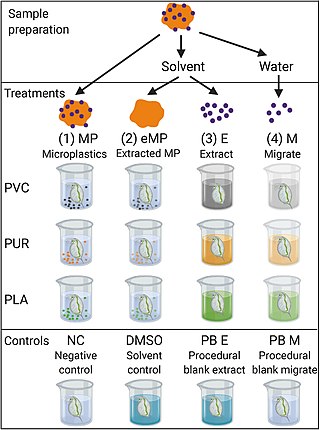Related Research Articles

Labeling a whole person as toxic is more toxic than any person.
Chronic toxicity, the development of adverse effects as a result of long term exposure to a contaminant or other stressor, is an important aspect of aquatic toxicology. Adverse effects associated with Chronic toxicity can be directly lethal but are more commonly sublethal, including changes in growth, reproduction, or behavior. Chronic toxicity is in contrast to acute toxicity, which occurs over a shorter period of time to higher concentrations. Various toxicity tests can be performed to assess the Chronic toxicity of different contaminants, and usually last at least 10% of an organism's lifespan. Results of aquatic Chronic toxicity tests can be used to determine water quality guidelines and regulations for protection of aquatic organisms.
A biocide is defined in the European legislation as a chemical substance or microorganism intended to destroy, deter, render harmless, or exert a controlling effect on any harmful organism. The US Environmental Protection Agency (EPA) uses a slightly different definition for biocides as "a diverse group of poisonous substances including preservatives, insecticides, disinfectants, and pesticides used for the control of organisms that are harmful to human or animal health or that cause damage to natural or manufactured products". When compared, the two definitions roughly imply the same, although the US EPA definition includes plant protection products and some veterinary medicines.
Risk assessment determines possible mishaps, their likelihood and consequences, and the tolerances for such events. The results of this process may be expressed in a quantitative or qualitative fashion. Risk assessment is an inherent part of a broader risk management strategy to help reduce any potential risk-related consequences.
In toxicology, the lethal dose (LD) is an indication of the lethal toxicity of a given substance or type of radiation. Because resistance varies from one individual to another, the "lethal dose" represents a dose at which a given percentage of subjects will die. The lethal concentration is a lethal dose measurement used for gases or particulates. The LD may be based on the standard person concept, a theoretical individual that has perfectly "normal" characteristics, and thus not apply to all sub-populations.

Aquatic toxicology is the study of the effects of manufactured chemicals and other anthropogenic and natural materials and activities on aquatic organisms at various levels of organization, from subcellular through individual organisms to communities and ecosystems. Aquatic toxicology is a multidisciplinary field which integrates toxicology, aquatic ecology and aquatic chemistry.

Ecotoxicology is the study of the effects of toxic chemicals on biological organisms, especially at the population, community, ecosystem, and biosphere levels. Ecotoxicology is a multidisciplinary field, which integrates toxicology and ecology.
Measures of pollutant concentration are used to determine risk assessment in public health.
Toxic equivalency factor (TEF) expresses the toxicity of dioxins, furans and PCBs in terms of the most toxic form of dioxin, 2,3,7,8-TCDD. The toxicity of the individual congeners may vary by orders of magnitude.
Cancer slope factors (CSF) are used to estimate the risk of cancer associated with exposure to a carcinogenic or potentially carcinogenic substance. A slope factor is an upper bound, approximating a 95% confidence limit, on the increased cancer risk from a lifetime exposure to an agent by ingestion or inhalation. This estimate, usually expressed in units of proportion affected per mg of substance/kg body weight-day, is generally reserved for use in the low-dose region of the dose-response relationship, that is, for exposures corresponding to risks less than 1 in 100.
Slope factors are also referred to as cancer potency factors (PF).
In environmental toxicology, effects range low (ERL) and effects range median (ERM) are measures of toxicity in marine sediment. They are used by public agencies in the United States in formulating guidelines in assessing toxicity hazards, in particular from trace metals or organic contaminants.
Tissue residue is the concentration of a chemical or compound in an organism's tissue or in a portion of an organism's tissue. Tissue residue is used in aquatic toxicology to help determine the fate of chemicals in aquatic systems, bioaccumulation of a substance, or bioavailability of a substance, account for multiple routes of exposure, and address an organism's exposure to chemical mixtures. A tissue residue approach to toxicity testing is considered a more direct and less variable measure of chemical exposure and is less dependent on external environmental factors than measuring the concentration of a chemical in the exposure media.
Toxicodynamics, termed pharmacodynamics in pharmacology, describes the dynamic interactions of a toxicant with a biological target and its biological effects. A biological target, also known as the site of action, can be binding proteins, ion channels, DNA, or a variety of other receptors. When a toxicant enters an organism, it can interact with these receptors and produce structural or functional alterations. The mechanism of action of the toxicant, as determined by a toxicant’s chemical properties, will determine what receptors are targeted and the overall toxic effect at the cellular level and organismal level.
The maximum acceptable toxicant concentration (MATC) is a value that is calculated through aquatic toxicity tests to help set water quality regulations for the protection of aquatic life. Using the results of a partial life-cycle chronic toxicity test, the MATC is reported as the geometric mean between the No Observed Effect Concentration (NOEC) and the lowest observed effect concentration (LOEC).
Predictive intake modelling uses mathematical modelling strategies to estimate intake of food, personal care products, and their formulations.
Equilibrium partitioning Sediment Benchmarks (ESBs) are a type of Sediment Quality Guideline (SQG) derived by the US Environmental Protection Agency (EPA) for the protection of benthic organisms. ESBs are based on the bioavailable concentration of contaminants in sediments rather than the dry-weight concentration. It has been demonstrated that sediment concentrations on a dry-weight basis often do not predict biological effects. Interstitial water concentrations, however, predict biological effects much better. This is true because the chemical present in the interstitial water (or pore water) is the uncomplexed/free phase of the chemical that is bioavailable and toxic to benthic organisms. Other phases of the chemical are bound to sediment particles like organic carbon (OC) or acid volatile sulfides (AVS) and are not bioavailable. Thus the interstitial water concentration is important to consider for effects to benthic organisms.
Tolerable weekly intake (TWI) estimates the amount per unit body weight of a potentially harmful substance or contaminant in food or water that can be ingested over a lifetime without risk of adverse health effects. TWI is generally preceded by "provisional" to indicate insufficient data exists, increasing uncertainty. The term TWI should be reserved for when there is a well-established and internationally accepted tolerance, backed by sound and uncontested data. Although similar in concept to tolerable daily intake (TDI), which is of the same derivation of acceptable daily intakes (ADIs), TWI accounts for contaminants that do not clear the body quickly and may accumulate within the body over a period of time. An example is heavy metals such as arsenic, cadmium, lead, and mercury. The concept of TWI takes into account daily variations in human consumption patterns.
Toxicological databases are large compilations of data derived from aquatic and environmental toxicity studies. Data is aggregated from a large number of individual studies in which toxic effects upon aquatic and terrestrial organisms have been determined for different chemicals. These databases are then used by toxicologists, chemists, regulatory agencies and scientists to investigate and predict the likelihood that an organic or inorganic chemical will cause an adverse effect on exposed organisms.
The acute to chronic ratio (ACR) uses acute toxicity data to gauge the chronic toxicity (MATC) of a chemical of interest to an organism. The science behind determining a safe concentration to the environment is imperfect, statistically limited, and resource intensive. There is an unfilled demand for the rapid assessment of different chemical toxicity to many different organisms. The ACR is a proposed solution to this demand.
Threshold dose is the minimum dose of drug that triggers minimal detectable biological effect in an animal. At extremely low doses, biological responses are absent for some of the drugs. The increase in dose above threshold dose induces an increase in the percentage of biological responses. Several benchmarks have been established to describe the effects of a particular dose of drug in a particular species, such as NOEL(no-observed-effect-level), NOAEL(no-observed-adverse-effect-level) and LOAEL(lowest-observed-adverse-effect-level). They are established by reviewing the available studies and animal studies. The application of threshold dose in risk assessment safeguards the participants in human clinical trials and evaluates the risks of chronic exposure to certain substances. However, the nature of animal studies also limits the applicability of experimental results in the human population and its significance in evaluating potential risk of certain substances. In toxicology, there are some other safety factors including LD50, LC50 and EC50.
References
- 1 2 3 4 5 6 7 8 9 10 11 European Chemicals Bureau. (2003). Technical Guidance Document on Risk Assessment. European Communities Archived 2021-07-06 at the Wayback Machine
- ↑ Predicted No Effect Concentration. 2015. Greenfacts. Available online at: http://www.greenfacts.org/glossary/pqrs/PNEC-predicted-no-effect-concentration.htm
- 1 2 3 Lei, Bing L.; Huang, Sheng B.; Jin, Xiao W.; Wang, Zijian (2010). "Deriving the aquatic predicted no-effect concentrations (PNECs) of three chlorophenols for the Taihu Lake, China". Journal of Environmental Science and Health, Part A. 45 (14): 1823–1831. Bibcode:2010JESHA..45.1823L. doi:10.1080/10934529.2010.520495. PMID 20936560. S2CID 9609498.
- ↑ Manuilova, A. (2003). Methods and Tools Available for Assessment of Environmental Risk. Dantes. Archived 2016-03-04 at the Wayback Machine
- ↑ "EU Risk assessment summary report". echa.europa.eu. Retrieved 24 September 2023.
- 1 2 3 4 5 6 Van Sprang, P. 2011. Data compilation, selection and derivation of PNEC values for the aquatic compartment Zinc example. OECD. Available online at: http://www.oecd.org/chemicalsafety/risk-assessment/48720427.pdf
- 1 2 3 4 5 6 The Edinburgh Centre for Toxicology. Accessed 2015. Environmental Risk Assessment. UNEP/IPCS Training Module No. 3. Section B. Available online at: "Archived copy" (PDF). Archived from the original (PDF) on 2015-05-28. Retrieved 2015-05-30.
{{cite web}}: CS1 maint: archived copy as title (link) - ↑ Jin, Xiaowei; Zha, Jinmiao; Xu, Yiping; Giesy, John P.; Richardson, Kristine L.; Wang, Zijian (2012). "Derivation of predicted no effect concentrations (PNEC) for 2,4,6-trichlorophenol based on Chinese resident species". Chemosphere. 86 (1): 17–23. Bibcode:2012Chmsp..86...17J. doi:10.1016/j.chemosphere.2011.08.040. PMID 21955353.
- ↑ Shaw-Allen, P. and G. W. Suter II. 2012. Species Sensitivity Distributions (SSDs). CADDIS Volume 4: Data Analysis. EPA. Available online at: http://www.epa.gov/caddis/da_advanced_2.html
- ↑ Wheeler, J.R; Grist, E.P.M; Leung, K.M.Y; Morritt, D.; Crane, M. (2002). "Species sensitivity distributions: Data and model choice". Marine Pollution Bulletin. 45 (1–12): 192–202. Bibcode:2002MarPB..45..192W. doi:10.1016/S0025-326X(01)00327-7. PMID 12398385.
- ↑ European Chemicals Agency. 2009. Guidance in a nutshell Chemical safety assessment. Available online at: https://echa.europa.eu/documents/10162/13632/nutshell_guidance_csa_en.pdf Archived 2016-05-09 at the Wayback Machine
- ↑ European Chemicals Agency. 2008. Guidance on information requirements and chemical safety assessment. Chapter R.10: Characterisation of dose [concentration]-response for environment. Available online at: https://echa.europa.eu/documents/10162/13632/information_requirements_r10_en.pdf Archived 2020-09-18 at the Wayback Machine
- ↑ MERAG. 2007. Risk characterization: general aspects. Metals Environmental Risk Assessment Guidance. Available online at: https://www.icmm.com/document/253 Archived 2016-03-04 at the Wayback Machine
- ↑ ECETOC. 1993. Environmental Hazard Assessment of Substances. European Centre for Ecotoxicology and Toxicology of Chemicals. Available online at: http://www.ecetoc.org/index.php?mact=MCSoap,cntnt01,details,0&cntnt01by_category=5&cntnt01template=display_list_v2&cntnt01order_by=Number%20Desc&cntnt01display_template=display_details_v2&cntnt01document_id=229&cntnt01returnid=89